Video of the Week:
When is Watermelon Ripe on the Vine?
Upcoming Events:
August 20, 2015
Depot Market
1101 30 Road, Courtland, KS
5:00 pm - 8:00 pm
For more information, go to: http://www.hfrr.ksu.edu/doc4356.ashx
Development of No-Till Pumpkins for the Great Plains
September 1, 2015
Schwinn Produce Farm
17624 Santa Fe Trail, Leavenworth, KS
5:00 pm - 8:00 pm
For more information, go to: http://www.hfrr.ksu.edu/doc4357.ashx
Turfgrass:
For Seeding Success, Pay Attention to "Other Crop" on the Seed Label
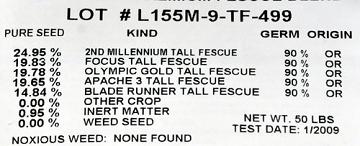
Orchardgrass is a problem because it is faster growing and lighter green than our turfgrasses. It is a bunch grass and so doesn’t spread, but infested areas are still unsightly due to small tufts of this species pockmarking the lawn.
Rough bluegrass is fine-textured and forms circular patches in the lawn. It blends in fairly well until summertime heat causes it to turn brown rapidly. If the rough bluegrass would just die in the heat, it would only be a temporary problem. Unfortunately, it usually just goes dormant, turning green again with cooler temperatures and rain.
Buying quality seed starts with knowing how to decipher the seed label. One of the most important things to look for is listed as "% other crop.” "Other crop" refers to any species that is intentionally grown for some purpose. That would include turfgrasses (those species other than the one you are buying) and pasture grasses. Orchardgrass and rough bluegrass both are listed as “other crop” seed. Seed labels are required by law to show the percentage (by weight) of "other crop" in the bag, but unless a species constitutes 5% or more, the label doesn't have to list each species by name.
How much "other crop" is too much? That’s a difficult question to answer, but the tolerance is very low. It depends on what the "other crop" actually is, and the quality expectations of the buyer. In practice, "other crop" may refer to something relatively harmless, like a small amount of perennial ryegrass in a bag of tall fescue, or it may refer to something bad, like rough bluegrass or orchardgrass. The homeowner really has no easy way of knowing what the "other crop" is, although there are some hints. If it is something bad, less than ½ of 1% can ruin a bag of seed. Obviously, if your expectations are high for the area you are planting, you would want the "other crop" to be as close to zero as possible. Good quality seed will often have 0.01% “other crop” or less. (Ward Upham)
Recommended Tall Fescue Cultivars
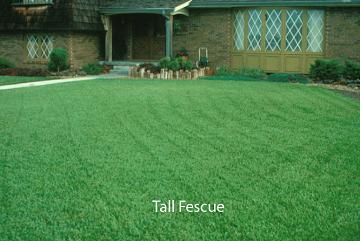
Each year the National Turfgrass Evaluation Trial rates tall fescue varieties for color, greenup, quality and texture. Quality ratings are taken once a month from March through October. K-31 consistently rates at the bottom. The highest rated cultivars were 3rd Millennium, Braveheart, Bullseye, Catalyst, Cochise, Corona, Escalade, Faith, Falcon V, Firecracker, Firenza, Jamboree, LS 1200, Monet, Mustang, Raptor II, Rhambler SRP, RK5, Shenandoah III, Shenandoah Elite, Sidewinder, Spyder LS, Talladega, Turbo and Wolfpack II.
There are a number of other cultivars that did not make this list but should do well in Kansas. Go to http://ntep.org/data/tf06/tf06_12-10f/tf0612ft04.txt . Any variety with a mean rating of 6.0 or above should be fine. K-31 has a rating of 4.1. Keep in mind that mixes of several varieties may allow you to take advantage of differing strengths. It is not necessary for mixes to contain only the varieties mentioned above.
Though K-31 may still be a good choice for large, open areas, the new cultivars will give better performance for those who desire a high-quality turf. (Ward Upham)
Kentucky Bluegrass Variety Selection for Cool-Season Lawns
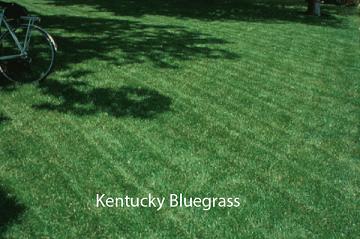
Recommended cultivars for high-quality lawns, where visual appearance is the prime concern, include Alexa II, Aura, Award, Bewitched, Barrister, Belissimo, Beyond, Diva, Everest, Everglade, Excursion, Ginney II, Granite, Impact, Midnight, NuChicago, NuGlade, NuDestiny, Rhapsody, Rhythm, Rugby, Skye, Solar Eclipse, STR 2485, Sudden Impact, Washington and Zifandel. Such lawns should receive 4 to 5 pounds nitrogen per 1,000 square feet per year and would typically be irrigated during dry periods to prevent drought stress.
Cultivars that do relatively well under a low-maintenance program with limited watering often differ from those that do well under higher inputs. Good choices for low maintenance include Baron, Baronie, Caliber, Canterbury, Dragon, Eagleton, Envicta, Kenblue, North Star, and South Dakota. Instead of the 4 to 5 pounds of nitrogen per 1,000 square feet per year, low-maintenance program would include 1 to 2 pounds of nitrogen per 1,000 square feet per year. Obviously, a low-input lawn will not be as attractive as a higher-input lawn, but you can expect the cultivars listed above to look fairly good in the spring and fall, while going dormant in the summer. (Ward Upham)
Fruit:
Fertilize Strawberries
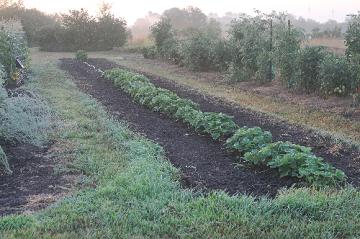
Nitrogen, applied mid August, will help promote fruit bud development. A general application rate is ½ to 3/4 pound of actual nitrogen per 100 feet of row. The nitrogen may be in the form of a fertilizer mixture such as ammonium phosphate or 12-12-12, or in a fertilizer containing only nitrogen such as urea or ammonium nitrate. Some specific examples would include:
Iron + (11-0-0) at 6 pounds per 100 feet of row.
12-12-12 at 5.5 pounds per 100 feet of row.
Nitrate of Soda (16-0-0) at 4 pounds per 100 feet of row
Ammonium sulfate (21-0-0) at 3 pounds per 100 feet of row
Urea (46-0-0) at 1.5 pounds per 100 feet of row
On sandy soils, the rate may be increased by about a half. After spreading the fertilizer, sprinkle the area applying at least a half-inch of water to move the nitrogen into the strawberry root areas. (Ward Upham)
Miscellaneous:
Field Dodder
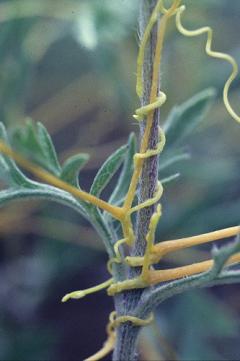
Because dodder is an annual, it must reproduce from seed. Plants present now will be killed by the first frost this fall. Seed may sprout in the spring or lie dormant for a number of years. Germination takes place in the soil, but roots die as soon as theplant finds an acceptable host. After attachment, dodder lives completely off the host plant. A single dodder plant can spread by branching and attacking additional host plants.
Destroying the host plants can control dodder, but this may not be an acceptable solution for many people. Dodder cannot be destroyed by pulling it off the host plants because remaining stem pieces will continue to grow. Trifluralin (Preen, Miracle-Gro Garden Weed Preventer, Treflan, Hi-Yield Herbicide Granules Weed and Grass Stopper) is a preemergence herbicide that can be used for control if applied before the dodder seed germinates. Also, glyphosate (Round-up, Kleen-up, Killzall, etc.) is effective on dodder. However, glyphosate is nonselective and will kill whatever it hits, including the host plants. (Ward Upham)
Pests:
Green June Beetle
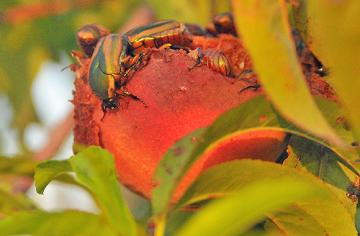
A number of general-use insecticides, including Sevin and malathion, may be used to discourage feeding. Sevin has a two-day waiting period between spraying and harvest on sweet corn and a three-day waiting period on peaches. There is a seven-day waiting period for Sevin on blackberries, so malathion, with a one-day waiting period, may be a better choice. (Ward Upham)
Tomatoes and Stinkbugs
Contributors: Ward Upham, Extension Associate
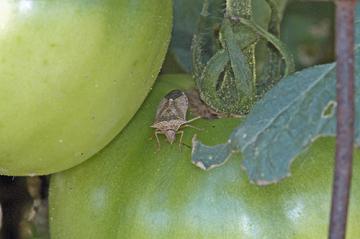
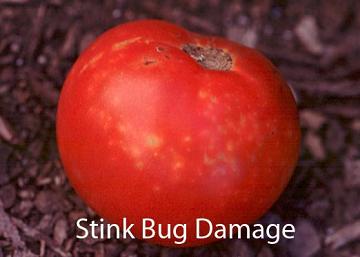
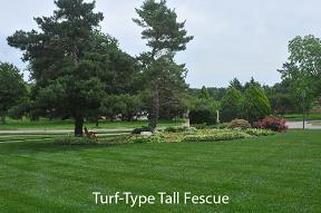
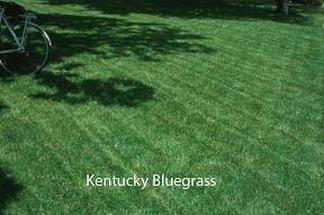
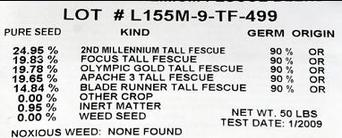
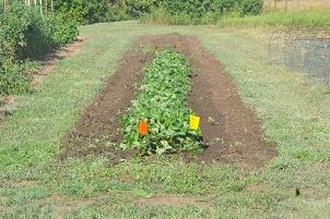
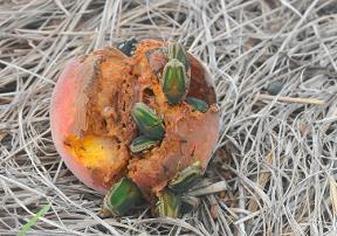
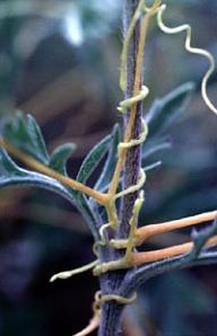
 RSS Feed
RSS Feed
